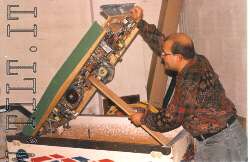Chapter 2:
The playfield

This is made up of two pieces of wood, joined in the middle and inclined towards the outholes at each end. The layout is simple with two flippers guarding each outhole and four more flippers for each player being located in the middle of the playfield (see picture #1 in the section below). That means there are eight flippers in the middle, four are red, being for the red player, and the other four are blue. Each player has two flipper buttons per side and a sticker bears the legend, "Forward button controls forward kickers; rear button controls rear kicker". Sounds simple enough but just wait until you try to play it! At my first attempt I found myself banging all the buttons like an absolute beginner. Apart from the flippers the playfield is left very open; there are no bumpers, just two slingshot kickers at the sides of the bottom flippers. The object of the game is to try to score a goal in the opposite outhole. On each side of the outholes are two lanes which the ball may enter. It is then immediately kicked back into play; this simulates a corner kick. When the ball goes into an outhole the bell rings and a goal is indicated by incrementing the numbered inset lights on the playfield, just above the outhole. The numbering goes from 1 to 10, so the maximum score is 19. The ball is now delivered to the lane to the player's right and kicked back into play. For those of you that are interested, the tunnel kickers are identical to the type used on Capersville as code zapper kickbacks (see picture #2 in the section below). Other lights on the playfield are "Game Over" and a 10 second warning lamp. Incidentally, timing is less than accurate! If the scores are tied at the end of time the game continues until the tie is broken. This feature can be turned off by the operator and then the game ends as soon as time runs out.
A curious circular sticker reads. "L.50 per gioco" (50 lira per game) (see picture #3 in the section below) and this leads me to believe that the game was intended to be shipped to Italy from the beginning. In order to access the inner mechanisms the playfield may be lifted from either end of the machine, but the stay, which supports it in the raised position, will only operate from one end. All the rubbers and lamps are original and the game plays well. There isn't much to say about game play as the rules have already been outlined. One unusual feature I discovered was a single lamp pointing towards the inner mechanism. At first I couldn't understand its purpose but then I realised that it illuminated the total plays counter, making it possible to read this without opening the game right up.
A problem that I have encountered is that some of the lamps are positioned very close to rebound rubbers, in the same place where normally the switch contacts would be found, and this makes them very susceptible to breakage. I checked under the playfield to see if this was an original feature and I concluded that it was. So, it would appear that the game was not modified after it left the factory. Therefore I have to consider the question: was the positioning of these lamps an error made only on my game, or did the error affect the whole production run? Maybe it was a late change and the designer didn't consider the full implications of the change. Such changes are not so rare. Look at the playfield of 4 Million BC. If you look at the scoring rubber just under the Volcano hole you will see that there is no score legend on the playfield here. All the other scoring rubbers have an arrow with the figure "10", so maybe this one was added after the playfield art had been completed. Furthermore, if you are familiar with the game you will know that this rubber is usually the first one the ball strikes if the player succeds in scoring the skill shot. Also, the 3000 point lamp turns off with the first 10 points scored. So, perhaps after initial testing someone came up with the idea of adding this rebound rubber to make the game harder. Conversely, if you look at the rubber under the Tar Pit gate you'll see some empty holes. Maybe someone intended contacts to be installed here at the design stage. Soon it was evident that the Tar Pit assembly would interfere with any contact fitted here; maybe in early games the assembly was positioned differently, or maybe it was of a different size. For whatever reason, the holes were left empty.
Back to BOOT-A-BALL, there isn't anything else worthy of note under the playfield (see picture #4 in the section below); all the parts are those that would normally be associated with a pinball. The slingshot kickers have been reinforced with the addition of a metal bar screwed from the kicker arm to the coil base. As the kickers and coils are of the same power used in a normal pinball I don't see the need for this modification.